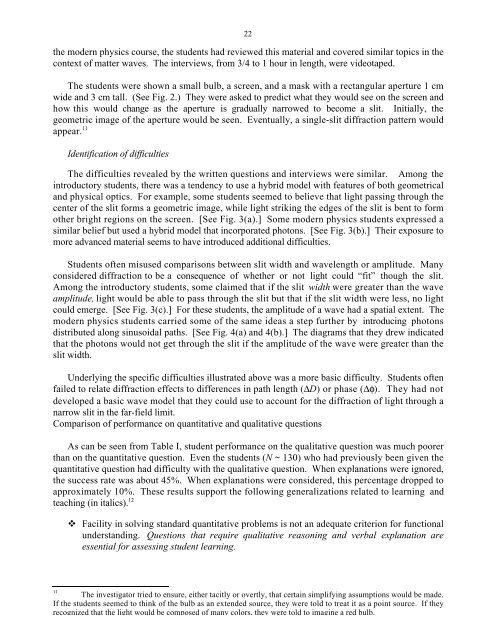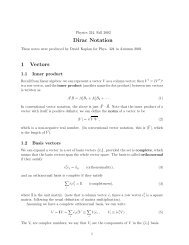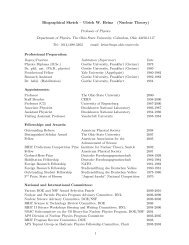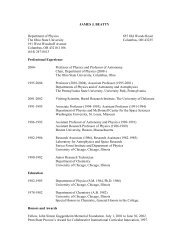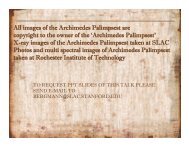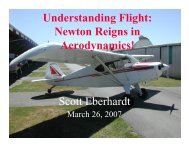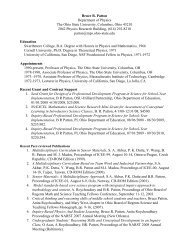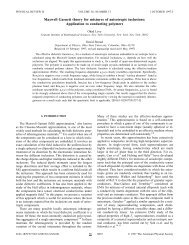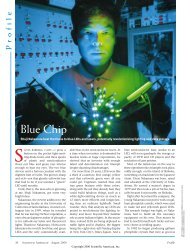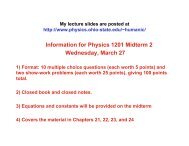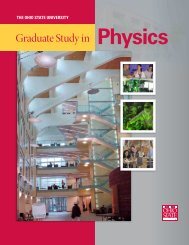Brasil Final Report - Department of Physics - The Ohio State University
Brasil Final Report - Department of Physics - The Ohio State University
Brasil Final Report - Department of Physics - The Ohio State University
Create successful ePaper yourself
Turn your PDF publications into a flip-book with our unique Google optimized e-Paper software.
22<br />
the modern physics course, the students had reviewed this material and covered similar topics in the<br />
context <strong>of</strong> matter waves. <strong>The</strong> interviews, from 3/4 to 1 hour in length, were videotaped.<br />
<strong>The</strong> students were shown a small bulb, a screen, and a mask with a rectangular aperture 1 cm<br />
wide and 3 cm tall. (See Fig. 2.) <strong>The</strong>y were asked to predict what they would see on the screen and<br />
how this would change as the aperture is gradually narrowed to become a slit. Initially, the<br />
geometric image <strong>of</strong> the aperture would be seen. Eventually, a single-slit diffraction pattern would<br />
appear. 11<br />
Identification <strong>of</strong> difficulties<br />
<strong>The</strong> difficulties revealed by the written questions and interviews were similar. Among the<br />
introductory students, there was a tendency to use a hybrid model with features <strong>of</strong> both geometrical<br />
and physical optics. For example, some students seemed to believe that light passing through the<br />
center <strong>of</strong> the slit forms a geometric image, while light striking the edges <strong>of</strong> the slit is bent to form<br />
other bright regions on the screen. [See Fig. 3(a).] Some modern physics students expressed a<br />
similar belief but used a hybrid model that incorporated photons. [See Fig. 3(b).] <strong>The</strong>ir exposure to<br />
more advanced material seems to have introduced additional difficulties.<br />
Students <strong>of</strong>ten misused comparisons between slit width and wavelength or amplitude. Many<br />
considered diffraction to be a consequence <strong>of</strong> whether or not light could “fit” though the slit.<br />
Among the introductory students, some claimed that if the slit width were greater than the wave<br />
amplitude, light would be able to pass through the slit but that if the slit width were less, no light<br />
could emerge. [See Fig. 3(c).] For these students, the amplitude <strong>of</strong> a wave had a spatial extent. <strong>The</strong><br />
modern physics students carried some <strong>of</strong> the same ideas a step further by introducing photons<br />
distributed along sinusoidal paths. [See Fig. 4(a) and 4(b).] <strong>The</strong> diagrams that they drew indicated<br />
that the photons would not get through the slit if the amplitude <strong>of</strong> the wave were greater than the<br />
slit width.<br />
Underlying the specific difficulties illustrated above was a more basic difficulty. Students <strong>of</strong>ten<br />
failed to relate diffraction effects to differences in path length (ΔD) or phase (Δφ). <strong>The</strong>y had not<br />
developed a basic wave model that they could use to account for the diffraction <strong>of</strong> light through a<br />
narrow slit in the far-field limit.<br />
Comparison <strong>of</strong> performance on quantitative and qualitative questions<br />
As can be seen from Table I, student performance on the qualitative question was much poorer<br />
than on the quantitative question. Even the students (N ~ 130) who had previously been given the<br />
quantitative question had difficulty with the qualitative question. When explanations were ignored,<br />
the success rate was about 45%. When explanations were considered, this percentage dropped to<br />
approximately 10%. <strong>The</strong>se results support the following generalizations related to learning and<br />
teaching (in italics). 12<br />
11<br />
Facility in solving standard quantitative problems is not an adequate criterion for functional<br />
understanding. Questions that require qualitative reasoning and verbal explanation are<br />
essential for assessing student learning.<br />
<strong>The</strong> investigator tried to ensure, either tacitly or overtly, that certain simplifying assumptions would be made.<br />
If the students seemed to think <strong>of</strong> the bulb as an extended source, they were told to treat it as a point source. If they<br />
recognized that the light would be composed <strong>of</strong> many colors, they were told to imagine a red bulb.


